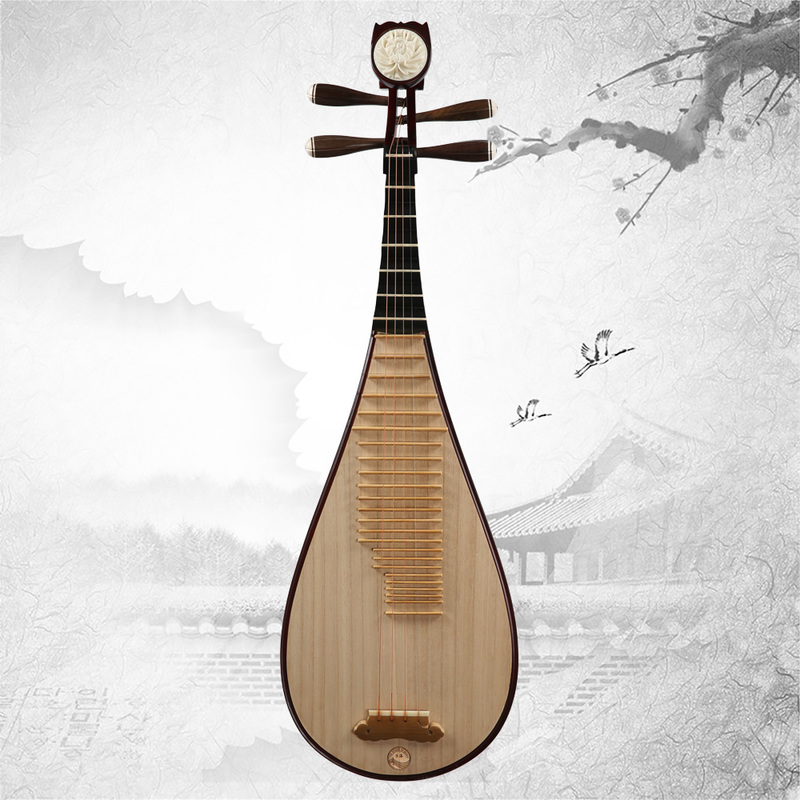Pipa 琵琶
Dublin Core
Title
Pipa 琵琶
Subject
Chinese music, Sound
Description
The Pipa is a four-stringed Chinese musical instrument, belonging to the plucked category of instruments. Sometimes called the Chinese lute, the instrument has a pear-shaped wooden body with a varying number of frets ranging from 12 to 26. According to Han dynasty sources, the origins of the name “pipa” refer to how the instrument is played. “Pi” meant “to play forward” and “pa” means “to play backward”. However, as no other types of sources reference this etymology; scholars suspect that the instrument more likely originated outside China, and that its name references a foreign language term.
Date
Han Dynasty (202 BC - 220 AD)
Format
Wooden texture, Height: 103cm, Width: 32cm
Type
Craft
Crafts Item Type Metadata
Crafting Methods
Modern pipas are made out of several types of materials. Their soundboards are made out of wutong wood, their frets and turning pegs are made of ivory, buffalo horns or wood, and their lower frets are made from bamboo.
The distinctive pear-shaped body with a short neck of the pipa is made from a solid piece of teak (see the first detail image for the reverse side of the instrument, where the single piece, or monoxyle, construction of the body, neck and pegbox is most evident). Wutong, a soft wood, is used for the soundboard. A side view perspective, as seen in the second detail image, reveals how shallow the hollowed out resonating chamber is on this instrument and how the plane of the strings rides just above the instrument’s many frets. The six peaked fret ledges (xiang) on the instrument's neck are made from a soft stone, while the twenty-five frets (pin) glued to the soundboard itself are made of bamboo strips. Four tuning pegs made from soft stone are laterally mounted onto the arched, back-bending pegbox. The four wire strings of varying gauges that are connected to these pegs pass over a nut at the top end of the fingerboard and are attached at their other end to a string fastener glued to the face of the soundboard that also serves as a bridge.
The distinctive pear-shaped body with a short neck of the pipa is made from a solid piece of teak (see the first detail image for the reverse side of the instrument, where the single piece, or monoxyle, construction of the body, neck and pegbox is most evident). Wutong, a soft wood, is used for the soundboard. A side view perspective, as seen in the second detail image, reveals how shallow the hollowed out resonating chamber is on this instrument and how the plane of the strings rides just above the instrument’s many frets. The six peaked fret ledges (xiang) on the instrument's neck are made from a soft stone, while the twenty-five frets (pin) glued to the soundboard itself are made of bamboo strips. Four tuning pegs made from soft stone are laterally mounted onto the arched, back-bending pegbox. The four wire strings of varying gauges that are connected to these pegs pass over a nut at the top end of the fingerboard and are attached at their other end to a string fastener glued to the face of the soundboard that also serves as a bridge.
Materials
Wood, Ivory, Buffalo horn, Bamboo, Stone
Usage and Application
Historically, it was at times used as a tool of self-refinement by members of the scholar-literati class and in the solo and ensemble music making of imperial households. But it has also been an instrument of the common people and used for the accompaniment of narrative songs and regional opera, and in amateur instrumental ensembles in many regions of China. Also associated with Buddhism, the pipa is often seen in the hands of angels in Buddhist iconography and incorporated into Buddhist narrative singing.
Collection
Citation
“Pipa 琵琶,” CCCH9051 Group 64, accessed January 18, 2026, https://learning.hku.hk/ccch9051/group-64/items/show/29.

